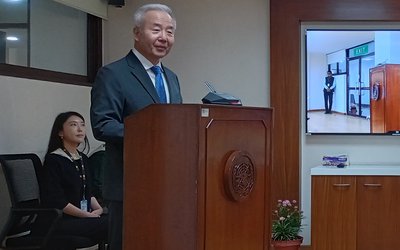
Along with Nepal’s two neighbors India and China, US is the third country, which jumped into action with rescue and relief operation as soon as the massive Earthquake hit Nepal on April 25.
Geologists and seismologists had warned for long that Kathmandu valley would have to see a major earthquake in the near future. USAID was well prepared to provide the materials at such times of requirement.
As its early preparation, USAID had also managed the materials people required at the time of quake. To meet urgent shelter demands following the Nepal Earthquake, 700 rolls of heavy-duty plastic sheeting were airlifted by USAID to help up to 17,500 people—or 3,500 families—whose homes were damaged or destroyed in the earthquake.
According to USAID, 2,000 sheets were delivered in Gorkha, 2,000 in Sindupalchowk, 1,000 in Kathmandu, and 500 in Dhading. USAID is planning to provide additional plastic sheeting and other materials in the coming days.
USAID Nepal has committed 2.5 million dollars to the World Food Program (WFP), which will buy and distribute 1,391 metric tons of rice, from either Nepal or India, to feed 120,000 people for a month.
According to a press release issued by Embassy of United States in Kathmandu, U.S. Embassy, in consultation with the Government of Nepal, WFP has already started distributing in Gorkha and Dhading. They will follow with Sindhupalchok, Nuwakot, and Rasuwa, and later the districts outside the Kathmandu valley.
A long time USAID partner, STC has developed robust local networks and is well-situated to quickly and efficiently distribute emergency relief supplies to hard-to-reach affected areas.
Following the miraculous rescue of Pema Lama in Gongabu, American search and rescue operations are underway with the 129-person Disaster Assistance Response Team (DART). In addition, a 20-person U.S. military joint humanitarian assistance survey team arrived on April 29 in Nepal to bolster the USAID DART response effort.
According to Embassy’s press release, the U.S. Government has committed $12.5 million in humanitarian funding to aid relief efforts in Nepal following the April 25 earthquake. U.S. Agency for International Development (USAID) funds totaling $12.5 million will reach urban and rural communities in the hardest hit districts throughout Nepal.
The Disaster Assistance Response Team (DART) includes teams of urban search and rescue personnel from Fairfax and Los Angeles County Fire Departments. The teams are rescuing survivors, identifying victims, and conducting life-saving assessments of buildings in earthquake-hit areas. In addition, a 20-person U.S. military joint humanitarian assistance survey team arrived on April 29 in Nepal to bolster the USAID DART response effort.
Priority concerns include shelter and protection for the estimated 2.8 million people displaced by the earthquake. Through partner organization Save the Children and with the support of Nepal Army helicopters, USAID helped distribute prepositioned shelter kits from the central region warehouse to 1,020 residents of the northern Gorkha District. USAID has authorized partner organizations, Nepal Contraceptive Retail Sales (Ghar Ghar Ma Swasthya Project) and World Wildlife Fund (Hariyo Ban Project), to distribute essential life support products such as health commodities, water, tents, food, and hygiene products to informal tented camps and affected districts including Lamjung, Gorkha, Rasuwa, and Dhading.
Of the total $12.5 million USAID funds, the USAID Office of Food for Peace will use $2.5 million to provide emergency food assistance to those most in need. In addition, USAID has already committed $1 million of this overall total to Save the Children to address the immediate shelter and water, sanitation, and hygiene (WASH) needs of earthquake victims. Additional funding will be distributed to relief agencies to provide materials, supplies, and expertise in support of earthquake relief efforts.
The U.S. Government continues to provide emergency relief, and has initiated preliminary plans to transition from relief efforts to resilient and sustainable long-term development efforts in earthquake-affected districts of Nepal.
This is not the first involvement of US in Nepal’s disaster management. US government through USAID has invested a lot of resources to improve the institutional and individual capability of Nepal. From security agencies to civilian bodies and civil society organizations, disaster is the priority sector of USAID in Nepal.
- IME GROUP: Expands Into Paper Industry
- Mar 24, 2025
- CPN UML: Instigated By India
- Mar 23, 2025
- ADB’S CHIEF ECONOMIST: Nepal Reduces Poverty
- Mar 11, 2025
- FM DR. DEUBA: A Successful Visit
- Mar 11, 2025
- MD GHISING: Target Of Personal Grudge
- Mar 09, 2025















